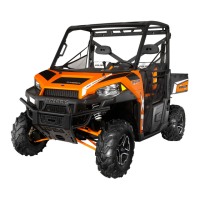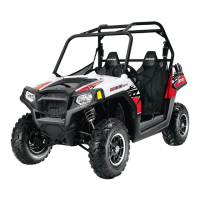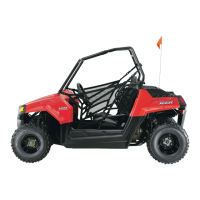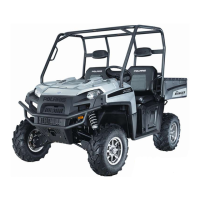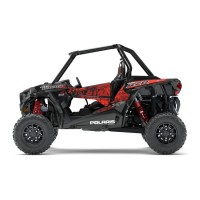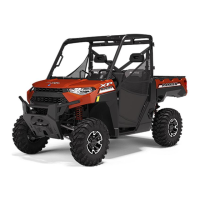BRAKES 4 - 3
November 2007 GEM Service Manual
SPONGY PEDAL
A spongy pedal is most often caused by air in the
system. However, thin brake rotors or brake drums
or substandard brake lines and hoses can also
cause a spongy pedal. The proper course of action
is to bleed the system, and replace the worn
components and substandard quality brake hoses if
suspected.
HARD PEDAL OR HIGH PEDAL EFFORT
A hard pedal or high pedal effort may be due to
brake pads or brake linings that are water soaked,
contaminated, glazed, or badly worn. The check
valve could also be faulty. Pedal pulsation is
caused by components that are loose, or beyond
tolerance limits. The primary cause of pulsation is
out of round brake rotors or brake drums. Other
causes are loose wheel bearings and worn,
damaged tires.
BRAKE NOISES
Some brake noise is common during the first few
stops after a vehicle has been parked overnight or
stored. This is primarily due to the formation of
trace corrosion (light rust) on metal surfaces. This
light corrosion is typically cleared from the metal
surfaces after a few brake applications causing the
noise to subside.
BRAKE SQUEAK OR SQUEAL
Brake squeak or squeal may be due to linings that
are wet or contaminated with brake fluid, grease, or
oil. Glazed linings and rotors with hard spots can
also contribute to squeak. Dirt and foreign material
embedded in the brake lining will also cause
squeak/ squeal. A very loud squeak or squeal is
frequently a sign of severely worn brake pads and
linings. If the pads or linings are worn through,
metal-to-metal contact occurs. If the condition is
allowed to continue, rotors and drums can become
so scored that replacement is necessary.
BRAKE CHATTER
Loose or worn components, or glazed/burnt linings
usually cause brake chatter. Additional causes of
chatter are rear brake linings not securely attached
to the shoes, loose wheel bearings and
contaminated brake linings.
THUMP OR CLUNK NOISE
Thumping or clunking noises during braking are
frequently not caused by brake components. In
many cases, such noises are caused by loose or
damaged steering, suspension, or engine
components. However, worn out, improperly
adjusted, or improperly assembled brake shoes can
also produce a thumping noise.
BRAKE BLEEDING
Brakes must be bled to remove air from the system
whenever the brake hoses or brake lines are
disconnected.
BLEEDING THE BRAKE SYSTEM
NOTE: Proper brake bleeding requires an
automotive type pressure bleeder or vacuum
bleeder. Good quality units are available from
reputable automotive tool companies.
WARNING: BRAKE FLUID IS TOXIC AND MUST
BE DISPOSED OF PROPERLY. FOLLOW
INSTRUCTIONS ON BRAKE FLUID CONTAINER
IN THE EVENT OF ACCIDENTAL CONTACT OR
INGESTION.
CAUTION: Use only DOT 3 brake fluid from an
unopened container.
CAUTION: Brake fluid will remove paint and
crack plastic. Immediately clean up any fluid
that gets on a painted or plastic surface.
STANDARD PROCEDURE - MANUAL - BLEEDING
Use brake fluid, or an equivalent quality fluid
meeting DOT 3 standards only. Use fresh, clean
fluid from a sealed container at all times.
1. Remove reservoir filler cap and fill reservoir.
2. If the front calipers or the rear wheel cylinders
were replaced or overhauled, open all bleed
screws. Close each bleed screw as fluid starts
to drip from it. Top off master cylinder reservoir
once more before proceeding.
